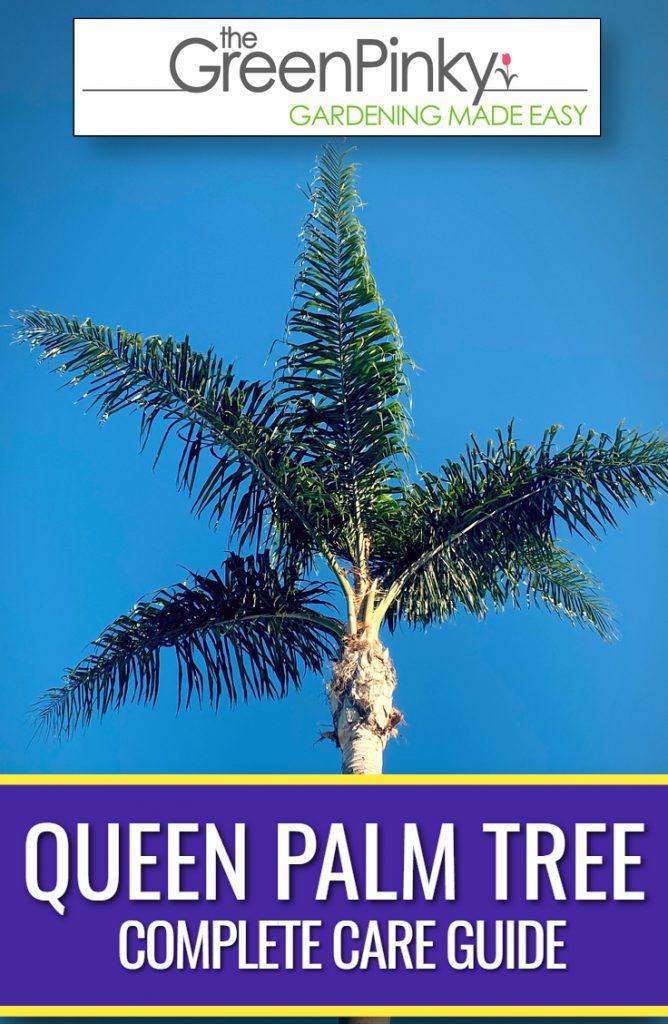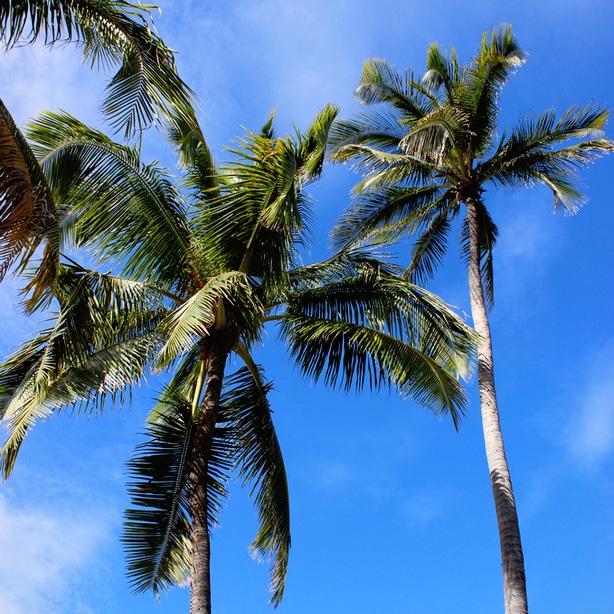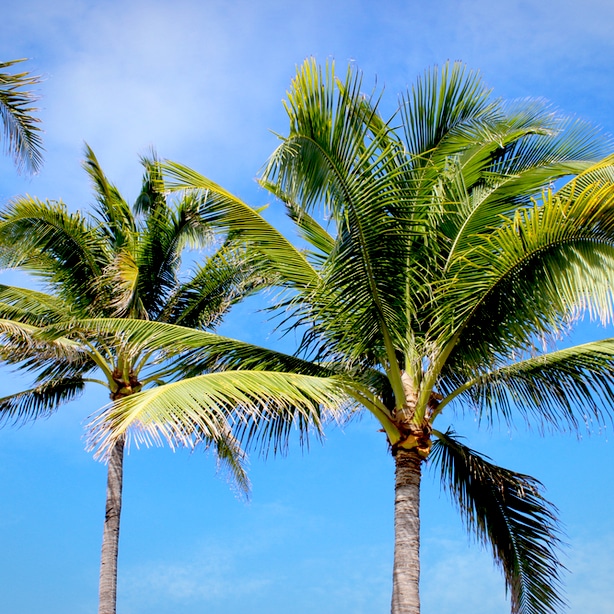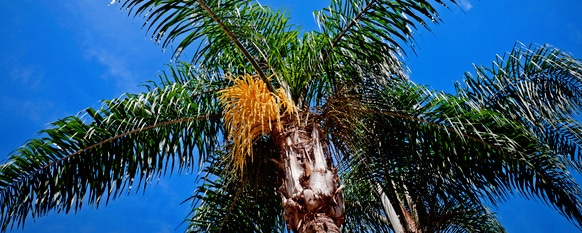The Queen Palm (Syagrus romanzoffiana) tree is one of the most popular ornamental palms used in landscaping. In the United States, it can be found filling the home landscapes of Southern California and the Gulf states. It is native to Brazil, Argentina, Uruguay, and Paraguay. It has spread to other parts of the world and is even considered an invasive species in Florida.
Queen Palms make a wonderful addition to garden landscapes and can tolerate a variety of climates. The species does require some consideration for their specialty care and maintenance. Once they grow too high, you will have to hire a professional to prune or treat the tops of the trees.
That being said, if you follow this general care guide, most issues should be prevented before they occur. Keep reading for our essential care tips and other information about this regal tree.
If you have a cottonwood tree on your property, you might want to check out our guide on taking care of cottonwood trees.

General Information
Queen Palm trees are best planted in USDA Hardiness Zones 9 through 11. The plant propagates itself through seeds found in the orange fruits, also known as dates. The seeds should be harvested before the fruit ripens, as mature fruit pulp releases a chemical that inhibits germination. The seeds will germinate in approximately two to three months in ideal conditions (well-watered potting soil and temperatures above 90°F).
After becoming established, it grows at a rate of about 6 feet per year. The fast-growing palms can grow to around 50 feet tall, but most individuals max out at around 30 to 40 feet tall. In addition to their tall heights, their crown of leaves can span as much as 25 feet.
The leaves of a palm tree are called “fronds”. The individual sections of a frond are referred to as “leaflets”. The fronds grow out of the top of the trunk and form the Queen Palm “crown”. This palm tree also grows plumes of small flower blossoms in the summer that produce clusters of fruit. The fruits fall off the palm when ripe.
Care Guide
Queen Palms perform well in sub-tropical and other warm environments. Depending on the area they are planted, they may require more or less care than palms in other regions. For instance, one that is planted in Palm Springs will require more frequent waterings than one that is in San Francisco. Consider your climate and rain patterns when choosing to plant one in your yard.
Proper care involves appropriate pruning and planting them in an ideal environment. Preventative maintenance goes a long way.

Amount of Sun
Queen Palms do well in partial shade or full sun. They prefer some shade, but they can also thrive in locations as warm and sunny as Phoenix, as long as they receive enough water.
Watering Frequency
Queen Palms prefer heavy soil moisture. They come from wet and rainy regions of the world, so they enjoy well-drained soil that is frequently watered. Water the palms approximately two to three times per week in most moderate climates. Watering in the evening, especially in hot climates, will help preserve moisture that would normally be lost to evaporation. The ground below the palm’s canopy can be mulched to preserve soil moisture.
They are commonly planted in desert regions. In order to survive the summer heat of places like Phoenix or Southern California, care must be taken to water your palms frequently. It is almost impossible to overwater them in the summer if you have well-drained soil. In climates with less heat, they do have drought tolerance to a certain extent.
Fertilization
Queen Palms prefer acidic soils. They will usually tolerate alkaline soils with a proper regimen of additional nutrients, such as manganese and iron.
Using commercially produced palm fertilizer is a great way to take the guesswork out of feeding your trees. Most will have the correct balance of nitrogen, phosphorus, and potassium, while adding in less common nutrients such as the aforementioned manganese and iron. Most palm fertilizers will be a slow-release variety, so you should only have to apply it once or twice a year.
Nutrient deficiencies and mineral deficiencies can often be identified by closely viewing the palm and its leaves. A potassium deficiency will cause yellowish-orange spots on mature leaves. A boron deficiency often causes new leaves to not open and form correctly. In addition, a boron deficiency will cause the “crown” of fronds to bend in one direction. A manganese deficiency will show up in the foliage, causing yellowing and dead spots along the veins of the fronds. These mineral deficiencies can be avoided or corrected with proper fertilization.

Pruning
Queen Palms usually require some amount of pruning, as they do not always drop their dead fronds. If you don’t care for the appearance of the dead and dying leaves, or if the tree is starting to suffer because of them, you can prune them. Only remove the fronds that are fully dead, leaving any leaves that still have green at the base of stem.
To prevent excessive stress, do not remove too many fronds at once. In addition, pruning is best performed in the fall season. Always cut the stems a few inches away from the trunk to avoid unnecessary injury to the tree. Specialty pruning tools are available to reach the high leaves of the tree.
Always be sure to clean up the pruned fronds, as the leaves can collect and provide a home for rats and snakes. They can also become a fire hazard.
Diseases
Queen Palms are susceptible to various fungal diseases. Ganoderma butt rot is caused by the species Ganoderma zonatum and is found in many palm trees species. The fungus invades the bottom 3-5 feet of the palm’s trunk, causing the trunk to degrade over time. If your palms are not doing well, it might be a good idea to check for conks (the fruiting bodies or mushrooms of G. Zonatum) around the base of the tree.
Thielaviopsis paradoxa is another potential pathogen that causes trunk rot. If one of your palms contracts a fungal disease, it is best to remove the palm before the fungus is able to spread to your other palm trees.

Differences Between Queen Palm Trees and Other Palm Trees
There are a variety of palm species that are relatively easy to distinguish from the Queen Palm. They all share a similar appearance but grow to different sizes and thrive in different environments.
The Pygmy Date Palm (Phoenix roebelenii) is instantly recognizable by its small size. The tree doesn’t usually grow taller than 10 feet and the fronds grow to about 3 feet long. Despite the name, the dates of the Pygmy Date Palm are not considered as edible and tasty as the fruit of other palm trees. Pygmy Date Palms are hardy in USDA Hardiness Zones 9 through 11 and enjoy full sun or partial shade.
The King Palm (Archontophoenix alexandrae), also known as the Alexander Palm, is the true patriarch of the palm tree family. Capable of growing from about 50 feet to 70 feet tall, the King Palm is a slightly larger variety than the Queen Palm. The species is self-cleaning and does not require much pruning, if any.The King Palm prefers well-drained soil and it can tolerate shade or full sun. However, it is less hardy than the Queen Palm and is only recommended for zones 10 and 11.
The Pineapple Palm (Phoenix canariensis), also known as the Canary Island Date Palm, is known for its large frond to trunk size ratio. The trunk’s slow growth rate allows it to support fronds that are over 10 feet in length. Unlike other palms, this species sports a pineapple-shaped growth in between the trunk and leaves. The trees are hardy in zones 9 through 11.

